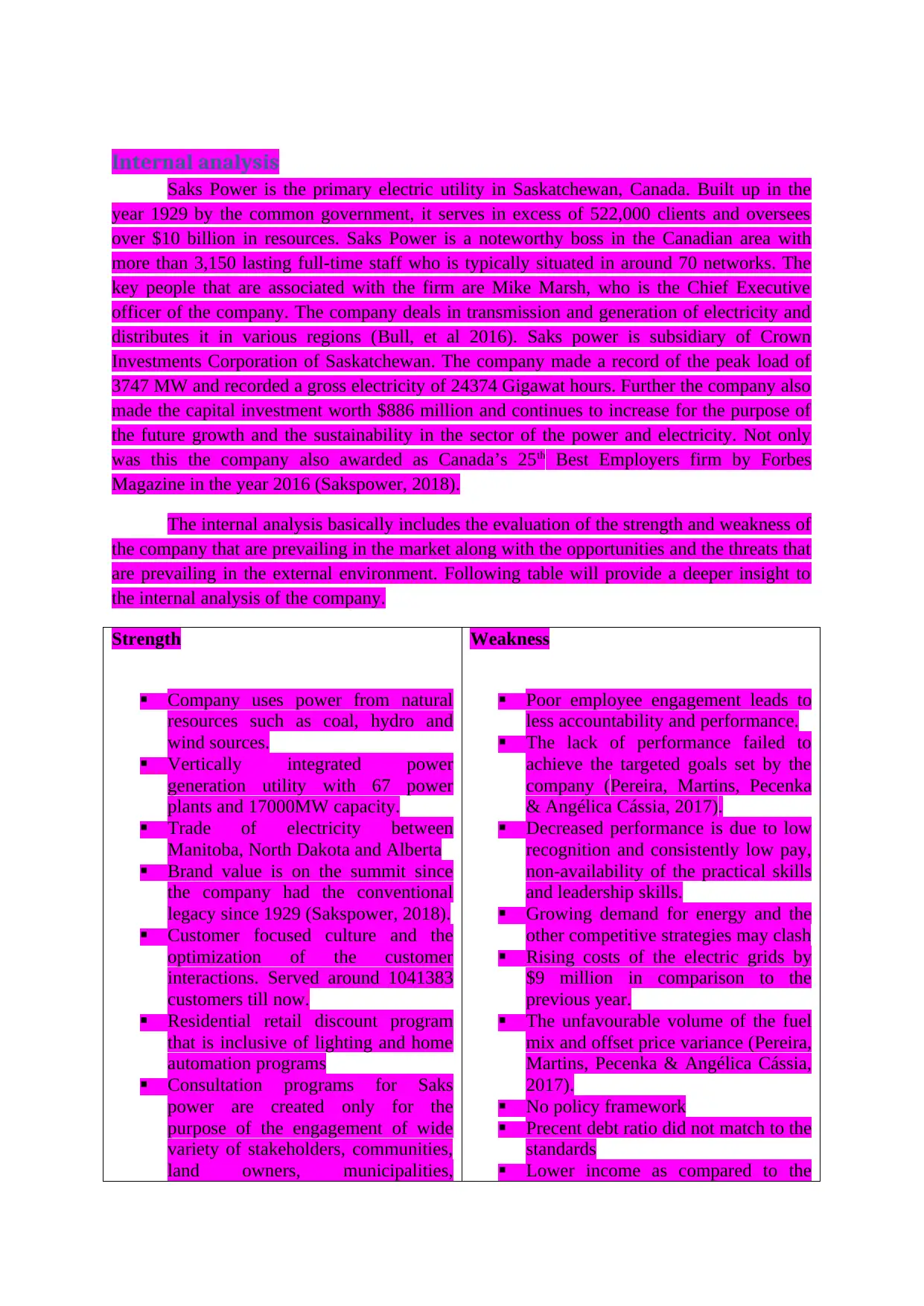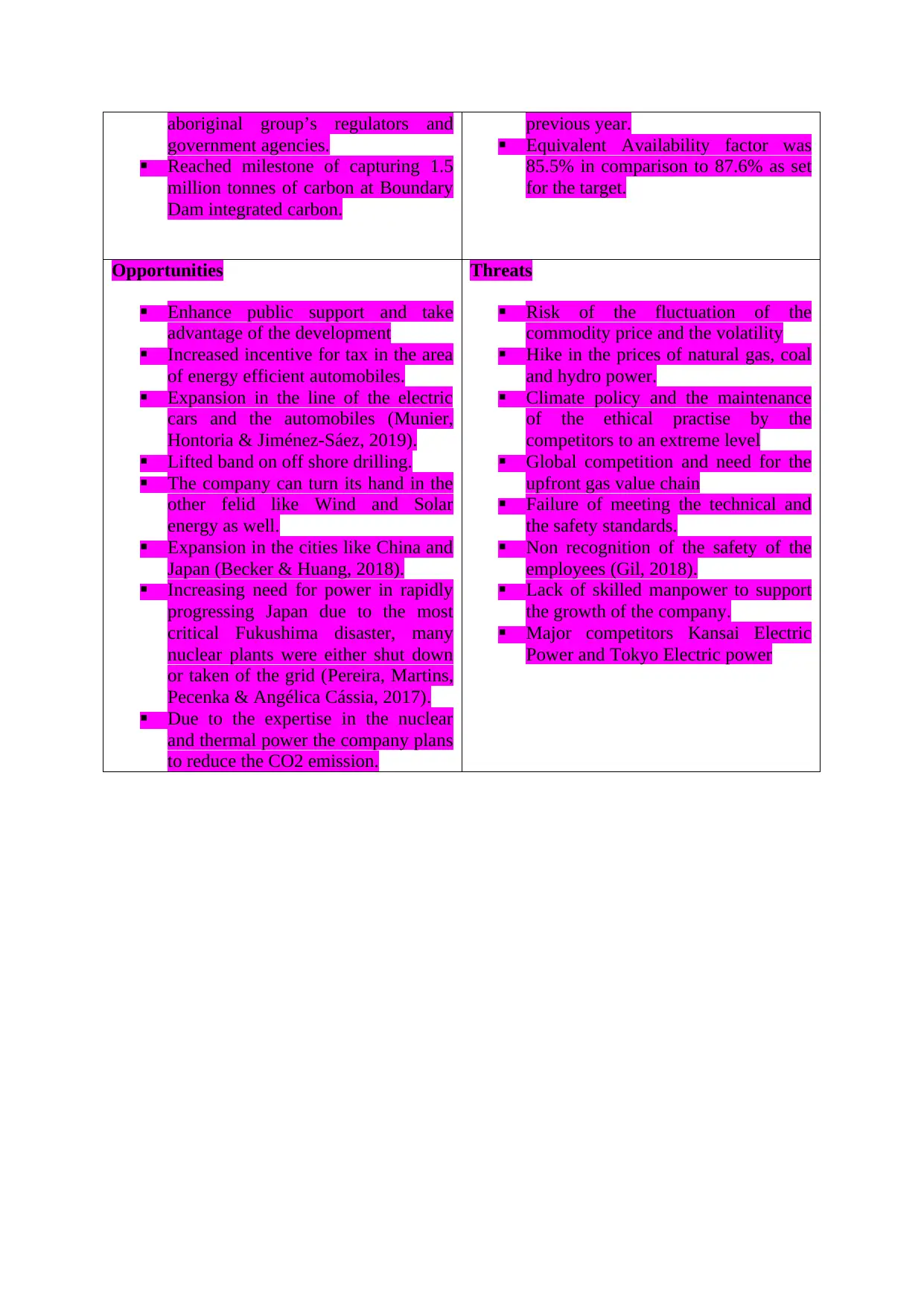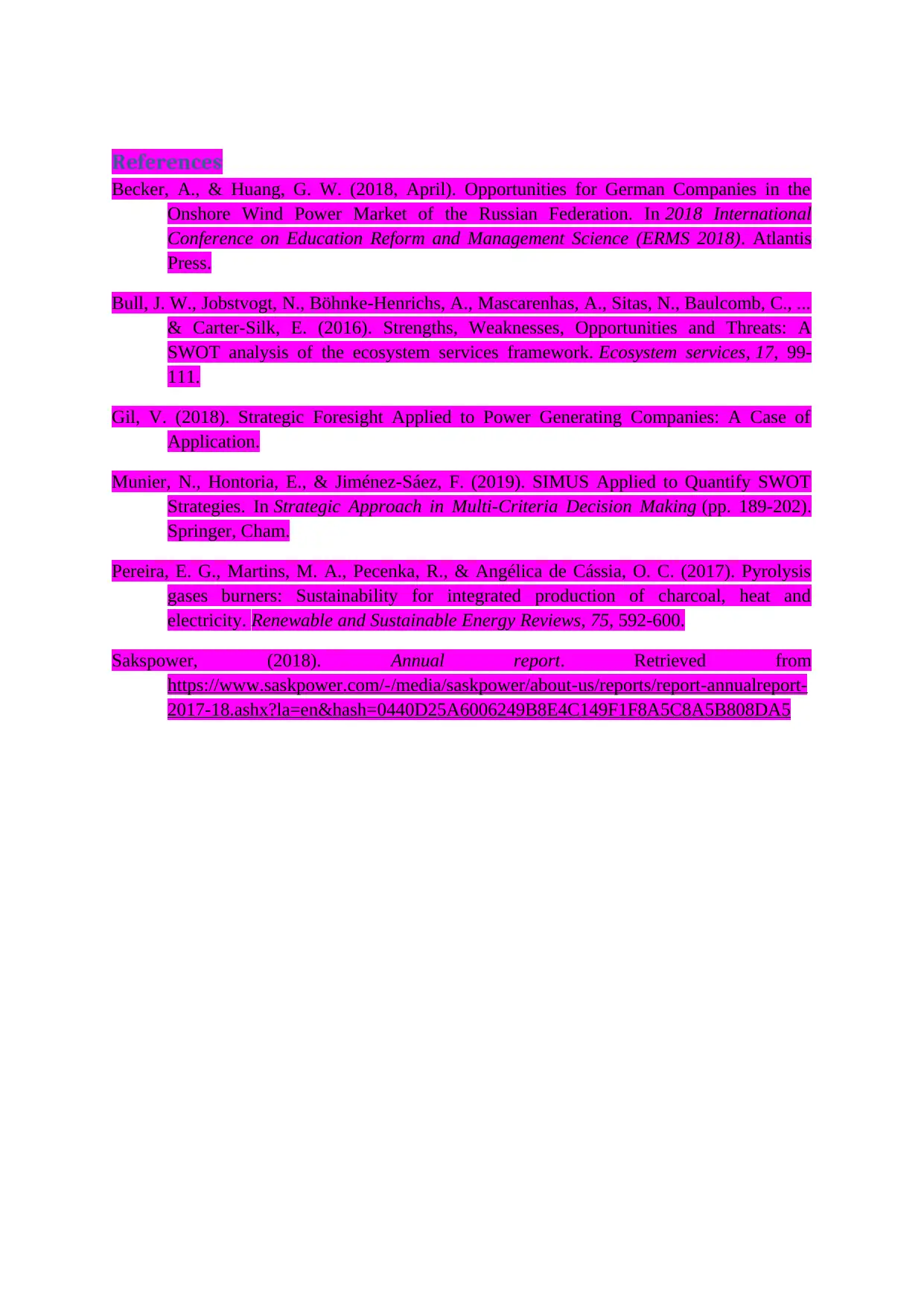Saks Power Case Study: Internal Analysis, SWOT, and Recommendations
VerifiedAdded on 2023/04/21
|3
|1062
|309
Case Study
AI Summary
This case study presents an internal analysis of Saks Power, a prominent electric utility in Saskatchewan, Canada. Established in 1929, Saks Power manages over $10 billion in assets and employs over 3,150 individuals. The analysis includes an evaluation of the company's strengths, such as its use of natural resources, vertically integrated power generation, and brand value, as well as its weaknesses, including poor employee engagement, rising costs, and lower income compared to the previous year. The study further explores opportunities like enhanced public support and expansion in the electric car market, alongside threats such as commodity price fluctuations, climate policy, and global competition. The analysis utilizes a SWOT framework to provide a comprehensive overview of Saks Power's internal and external environment, highlighting key strategic considerations for the company's future.

Internal analysis
Saks Power is the primary electric utility in Saskatchewan, Canada. Built up in the
year 1929 by the common government, it serves in excess of 522,000 clients and oversees
over $10 billion in resources. Saks Power is a noteworthy boss in the Canadian area with
more than 3,150 lasting full-time staff who is typically situated in around 70 networks. The
key people that are associated with the firm are Mike Marsh, who is the Chief Executive
officer of the company. The company deals in transmission and generation of electricity and
distributes it in various regions (Bull, et al 2016). Saks power is subsidiary of Crown
Investments Corporation of Saskatchewan. The company made a record of the peak load of
3747 MW and recorded a gross electricity of 24374 Gigawat hours. Further the company also
made the capital investment worth $886 million and continues to increase for the purpose of
the future growth and the sustainability in the sector of the power and electricity. Not only
was this the company also awarded as Canada’s 25th Best Employers firm by Forbes
Magazine in the year 2016 (Sakspower, 2018).
The internal analysis basically includes the evaluation of the strength and weakness of
the company that are prevailing in the market along with the opportunities and the threats that
are prevailing in the external environment. Following table will provide a deeper insight to
the internal analysis of the company.
Strength
Company uses power from natural
resources such as coal, hydro and
wind sources.
Vertically integrated power
generation utility with 67 power
plants and 17000MW capacity.
Trade of electricity between
Manitoba, North Dakota and Alberta
Brand value is on the summit since
the company had the conventional
legacy since 1929 (Sakspower, 2018).
Customer focused culture and the
optimization of the customer
interactions. Served around 1041383
customers till now.
Residential retail discount program
that is inclusive of lighting and home
automation programs
Consultation programs for Saks
power are created only for the
purpose of the engagement of wide
variety of stakeholders, communities,
land owners, municipalities,
Weakness
Poor employee engagement leads to
less accountability and performance.
The lack of performance failed to
achieve the targeted goals set by the
company (Pereira, Martins, Pecenka
& Angélica Cássia, 2017).
Decreased performance is due to low
recognition and consistently low pay,
non-availability of the practical skills
and leadership skills.
Growing demand for energy and the
other competitive strategies may clash
Rising costs of the electric grids by
$9 million in comparison to the
previous year.
The unfavourable volume of the fuel
mix and offset price variance (Pereira,
Martins, Pecenka & Angélica Cássia,
2017).
No policy framework
Precent debt ratio did not match to the
standards
Lower income as compared to the
Saks Power is the primary electric utility in Saskatchewan, Canada. Built up in the
year 1929 by the common government, it serves in excess of 522,000 clients and oversees
over $10 billion in resources. Saks Power is a noteworthy boss in the Canadian area with
more than 3,150 lasting full-time staff who is typically situated in around 70 networks. The
key people that are associated with the firm are Mike Marsh, who is the Chief Executive
officer of the company. The company deals in transmission and generation of electricity and
distributes it in various regions (Bull, et al 2016). Saks power is subsidiary of Crown
Investments Corporation of Saskatchewan. The company made a record of the peak load of
3747 MW and recorded a gross electricity of 24374 Gigawat hours. Further the company also
made the capital investment worth $886 million and continues to increase for the purpose of
the future growth and the sustainability in the sector of the power and electricity. Not only
was this the company also awarded as Canada’s 25th Best Employers firm by Forbes
Magazine in the year 2016 (Sakspower, 2018).
The internal analysis basically includes the evaluation of the strength and weakness of
the company that are prevailing in the market along with the opportunities and the threats that
are prevailing in the external environment. Following table will provide a deeper insight to
the internal analysis of the company.
Strength
Company uses power from natural
resources such as coal, hydro and
wind sources.
Vertically integrated power
generation utility with 67 power
plants and 17000MW capacity.
Trade of electricity between
Manitoba, North Dakota and Alberta
Brand value is on the summit since
the company had the conventional
legacy since 1929 (Sakspower, 2018).
Customer focused culture and the
optimization of the customer
interactions. Served around 1041383
customers till now.
Residential retail discount program
that is inclusive of lighting and home
automation programs
Consultation programs for Saks
power are created only for the
purpose of the engagement of wide
variety of stakeholders, communities,
land owners, municipalities,
Weakness
Poor employee engagement leads to
less accountability and performance.
The lack of performance failed to
achieve the targeted goals set by the
company (Pereira, Martins, Pecenka
& Angélica Cássia, 2017).
Decreased performance is due to low
recognition and consistently low pay,
non-availability of the practical skills
and leadership skills.
Growing demand for energy and the
other competitive strategies may clash
Rising costs of the electric grids by
$9 million in comparison to the
previous year.
The unfavourable volume of the fuel
mix and offset price variance (Pereira,
Martins, Pecenka & Angélica Cássia,
2017).
No policy framework
Precent debt ratio did not match to the
standards
Lower income as compared to the
Paraphrase This Document
Need a fresh take? Get an instant paraphrase of this document with our AI Paraphraser

aboriginal group’s regulators and
government agencies.
Reached milestone of capturing 1.5
million tonnes of carbon at Boundary
Dam integrated carbon.
previous year.
Equivalent Availability factor was
85.5% in comparison to 87.6% as set
for the target.
Opportunities
Enhance public support and take
advantage of the development
Increased incentive for tax in the area
of energy efficient automobiles.
Expansion in the line of the electric
cars and the automobiles (Munier,
Hontoria & Jiménez-Sáez, 2019).
Lifted band on off shore drilling.
The company can turn its hand in the
other felid like Wind and Solar
energy as well.
Expansion in the cities like China and
Japan (Becker & Huang, 2018).
Increasing need for power in rapidly
progressing Japan due to the most
critical Fukushima disaster, many
nuclear plants were either shut down
or taken of the grid (Pereira, Martins,
Pecenka & Angélica Cássia, 2017).
Due to the expertise in the nuclear
and thermal power the company plans
to reduce the CO2 emission.
Threats
Risk of the fluctuation of the
commodity price and the volatility
Hike in the prices of natural gas, coal
and hydro power.
Climate policy and the maintenance
of the ethical practise by the
competitors to an extreme level
Global competition and need for the
upfront gas value chain
Failure of meeting the technical and
the safety standards.
Non recognition of the safety of the
employees (Gil, 2018).
Lack of skilled manpower to support
the growth of the company.
Major competitors Kansai Electric
Power and Tokyo Electric power
government agencies.
Reached milestone of capturing 1.5
million tonnes of carbon at Boundary
Dam integrated carbon.
previous year.
Equivalent Availability factor was
85.5% in comparison to 87.6% as set
for the target.
Opportunities
Enhance public support and take
advantage of the development
Increased incentive for tax in the area
of energy efficient automobiles.
Expansion in the line of the electric
cars and the automobiles (Munier,
Hontoria & Jiménez-Sáez, 2019).
Lifted band on off shore drilling.
The company can turn its hand in the
other felid like Wind and Solar
energy as well.
Expansion in the cities like China and
Japan (Becker & Huang, 2018).
Increasing need for power in rapidly
progressing Japan due to the most
critical Fukushima disaster, many
nuclear plants were either shut down
or taken of the grid (Pereira, Martins,
Pecenka & Angélica Cássia, 2017).
Due to the expertise in the nuclear
and thermal power the company plans
to reduce the CO2 emission.
Threats
Risk of the fluctuation of the
commodity price and the volatility
Hike in the prices of natural gas, coal
and hydro power.
Climate policy and the maintenance
of the ethical practise by the
competitors to an extreme level
Global competition and need for the
upfront gas value chain
Failure of meeting the technical and
the safety standards.
Non recognition of the safety of the
employees (Gil, 2018).
Lack of skilled manpower to support
the growth of the company.
Major competitors Kansai Electric
Power and Tokyo Electric power

References
Becker, A., & Huang, G. W. (2018, April). Opportunities for German Companies in the
Onshore Wind Power Market of the Russian Federation. In 2018 International
Conference on Education Reform and Management Science (ERMS 2018). Atlantis
Press.
Bull, J. W., Jobstvogt, N., Böhnke-Henrichs, A., Mascarenhas, A., Sitas, N., Baulcomb, C., ...
& Carter-Silk, E. (2016). Strengths, Weaknesses, Opportunities and Threats: A
SWOT analysis of the ecosystem services framework. Ecosystem services, 17, 99-
111.
Gil, V. (2018). Strategic Foresight Applied to Power Generating Companies: A Case of
Application.
Munier, N., Hontoria, E., & Jiménez-Sáez, F. (2019). SIMUS Applied to Quantify SWOT
Strategies. In Strategic Approach in Multi-Criteria Decision Making (pp. 189-202).
Springer, Cham.
Pereira, E. G., Martins, M. A., Pecenka, R., & Angélica de Cássia, O. C. (2017). Pyrolysis
gases burners: Sustainability for integrated production of charcoal, heat and
electricity. Renewable and Sustainable Energy Reviews, 75, 592-600.
Sakspower, (2018). Annual report. Retrieved from
https://www.saskpower.com/-/media/saskpower/about-us/reports/report-annualreport-
2017-18.ashx?la=en&hash=0440D25A6006249B8E4C149F1F8A5C8A5B808DA5
Becker, A., & Huang, G. W. (2018, April). Opportunities for German Companies in the
Onshore Wind Power Market of the Russian Federation. In 2018 International
Conference on Education Reform and Management Science (ERMS 2018). Atlantis
Press.
Bull, J. W., Jobstvogt, N., Böhnke-Henrichs, A., Mascarenhas, A., Sitas, N., Baulcomb, C., ...
& Carter-Silk, E. (2016). Strengths, Weaknesses, Opportunities and Threats: A
SWOT analysis of the ecosystem services framework. Ecosystem services, 17, 99-
111.
Gil, V. (2018). Strategic Foresight Applied to Power Generating Companies: A Case of
Application.
Munier, N., Hontoria, E., & Jiménez-Sáez, F. (2019). SIMUS Applied to Quantify SWOT
Strategies. In Strategic Approach in Multi-Criteria Decision Making (pp. 189-202).
Springer, Cham.
Pereira, E. G., Martins, M. A., Pecenka, R., & Angélica de Cássia, O. C. (2017). Pyrolysis
gases burners: Sustainability for integrated production of charcoal, heat and
electricity. Renewable and Sustainable Energy Reviews, 75, 592-600.
Sakspower, (2018). Annual report. Retrieved from
https://www.saskpower.com/-/media/saskpower/about-us/reports/report-annualreport-
2017-18.ashx?la=en&hash=0440D25A6006249B8E4C149F1F8A5C8A5B808DA5
⊘ This is a preview!⊘
Do you want full access?
Subscribe today to unlock all pages.

Trusted by 1+ million students worldwide
1 out of 3
Your All-in-One AI-Powered Toolkit for Academic Success.
+13062052269
info@desklib.com
Available 24*7 on WhatsApp / Email
![[object Object]](/_next/static/media/star-bottom.7253800d.svg)
Unlock your academic potential
Copyright © 2020–2025 A2Z Services. All Rights Reserved. Developed and managed by ZUCOL.
